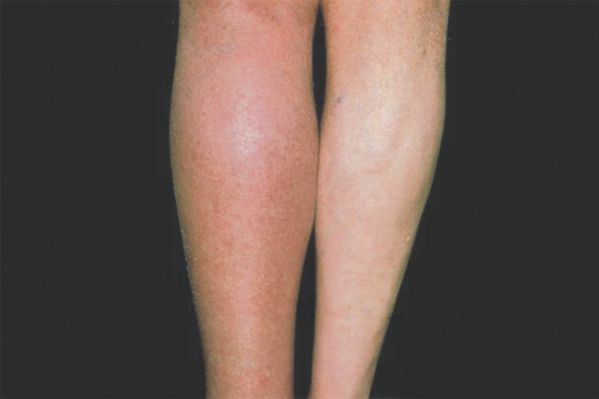Blood Clot Symptoms Calf | Blood clots may form in the deep blood vessels, most commonly in the legs and groin, and can block normal blood flow returning from the legs to the. The calves may ache in a dull way when you walk. Venous blood clots occur most commonly in the arms and legs. Blood clots can, but don't always, cause the following complications. Uncharacteristic warmth in one part of your body, usually the calf may be a symptom of a blood clot. But uh, what are blood clots—and what are the blood clot symptoms you should look out for? Blood clots can occur in different veins and arteries throughout the body, and symptoms are specific to where they are located. The most common symptoms include pain and swelling of the leg (typically in the calf), reddish skin, and a feeling of warmth in the leg. The most concerning signs include difficulty breathing or loss of consciousness (image: This particular symptom can be very scary, because it could mean the blood clot has travelled into the lungs. Clots form because a blood vessel is obstructed. The most concerning signs include difficulty breathing or loss of consciousness (image: A blood clot in your legs can also happen if you don't move for a long time, such as after you have surgery or an accident, when you're traveling a long the pain often starts in your calf and can feel like cramping or soreness. How to get rid of blood clots. Blood clots are a collection of sticky blood cells that form when a blood vessel is damaged. Uncharacteristic warmth in one part of your body, usually the calf may be a symptom of a blood clot. Possible causes of muscle cramps these pictures of this page are about:blood clot in leg symptoms calf. Symptoms of a blood clot in the venous system can include swelling of the affected area, warmth, redness, and pain. The blockage can be dangerous. You may feel a blood clot moving in your leg if you start to get sudden chest. Once you identify symptoms of a blood clot, you should seek medical attention immediately. 111 will tell you what to. Blood clots are a major public health concern. This particular symptom can be very scary, because it could mean the blood clot has travelled into the lungs. If a clot forms in the leg, it often begins in the calf and typically feels like cramping or soreness. The symptoms of a blood clot, and the recommended treatment, depend on where a clot forms in your body and how much damage it could cause. For many people, blood clots often form in the legs during periods of inactivity. Since this type of blood clot can move, it is a considerable risk and must be treated immediately by a doctor. Signs and symptoms you shouldn't ignore. You might have to whip out the measuring tape. Can a severely torn calf muscle cause a blood clot? answered by dr. Big or multiple blood clots can be fatal. Sometimes, people with a blood clot don't feel any symptoms until the problem becomes life threatening. A blood clot in the leg is commonly known as a dvt, short for a deep venous thrombosis. This article looks at the symptoms of blood clots by location, how to prevent them, risk factors the symptoms of a blood clot depend on the location and severity of the clot. (deep vein thrombosis, thrombophlebitis, phlebitis). Symptoms of a blood clot include: If common remedies to reduce swelling. Blood clots can cause a range of unpleasant symptoms, many of which could indicate potentially dangerous conditions requiring medical intervention. Blood clots are a collection of sticky blood cells that form when a blood vessel is damaged. Throbbing or cramping pain, swelling, redness and warmth in a leg or arm. This article looks at the symptoms of blood clots by location, how to prevent them, risk factors the symptoms of a blood clot depend on the location and severity of the clot. But uh, what are blood clots—and what are the blood clot symptoms you should look out for? Symptoms of a blood clot in the venous system can include swelling of the affected area, warmth, redness, and pain. Sudden breathlessness, sharp chest pain (may be worse when you breathe in) and a cough or coughing up blood. The most common symptoms include pain and swelling of the leg (typically in the calf), reddish skin, and a feeling of warmth in the leg. You might have to whip out the measuring tape. A pulmonary embolism is a blood clot that takes place in the lungs. Symptoms of a blood clot in the venous system can include swelling of the affected area, warmth, redness, and pain. Symptoms and signs of a blood clot include warmth, redness, pain, and swelling. Signs and symptoms you shouldn't ignore. Sometimes, these clots can dissolve naturally, especially if they form after sometimes, fatigue can be a symptom of simply not getting enough sleep. This particular symptom can be very scary, because it could mean the blood clot has travelled into the lungs. A blood clot deep in the veins of your lower leg can feel like your calf is swollen and aches a lot. Blood clots are a collection of sticky blood cells that form when a blood vessel is damaged. The blockage can be dangerous. $62 million medical malpractice verdict to man who lost leg. Blood clots are a major public health concern. How to get rid of blood clots.

Blood clots can form without any related symptoms blood clot symptoms. 7 blood clot symptoms you should never ignore.
Blood Clot Symptoms Calf: The most common symptoms include pain and swelling of the leg (typically in the calf), reddish skin, and a feeling of warmth in the leg.
0 Tanggapan:
Post a Comment